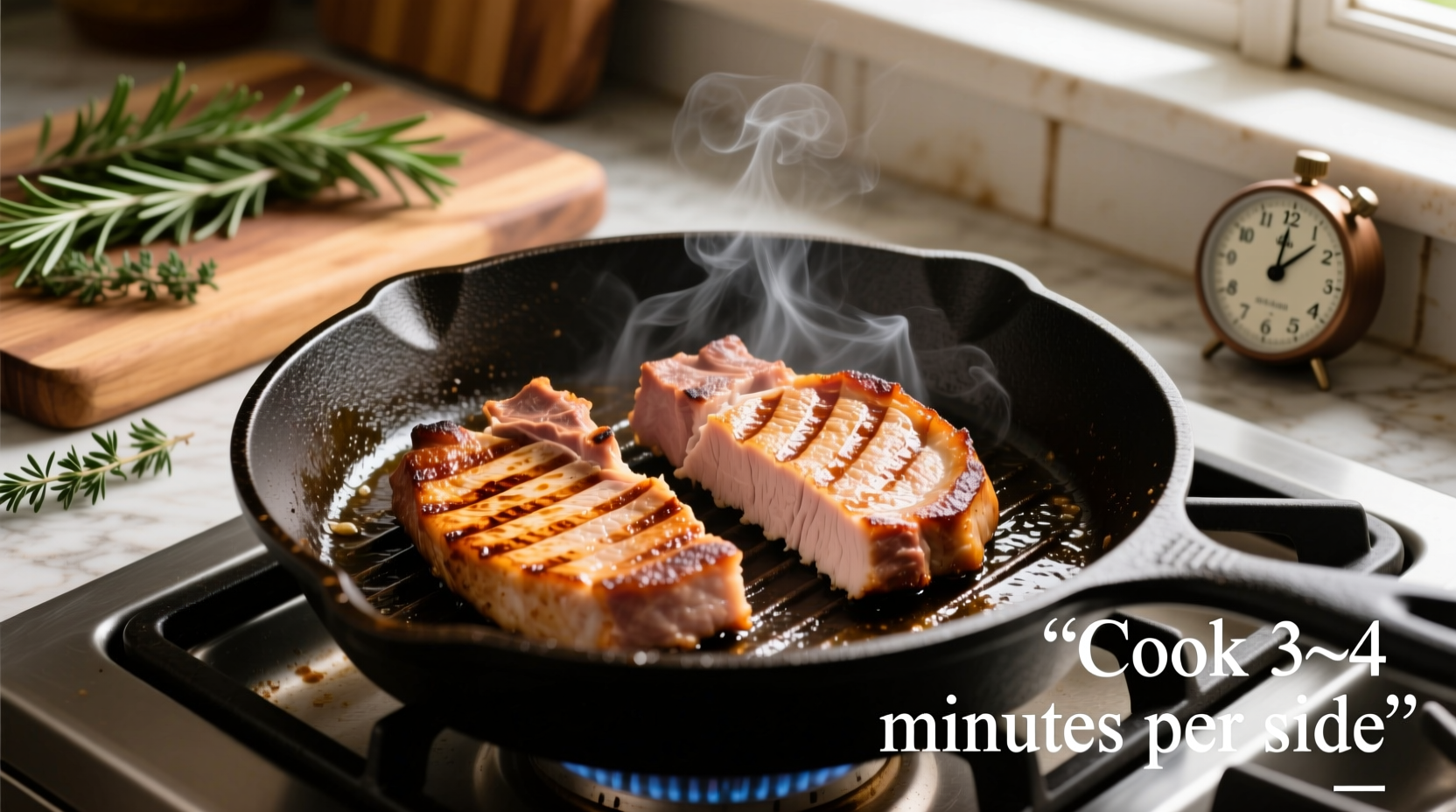Getting perfectly cooked thin pork chops doesn't require culinary school training—just understanding the science behind quick-cooking proteins. As someone who's spent years teaching home cooks professional techniques, I've seen how the right timing transforms what many consider a tricky cut into a weeknight dinner hero.
Why Thin Pork Chops Cook So Fast (And How to Get It Right)
Thin pork chops cook rapidly because their reduced thickness allows heat to penetrate quickly. Unlike thicker cuts that need careful temperature management to avoid a gray ring, thin chops demand precision timing. The USDA Food Safety and Inspection Service confirms that pork is safe to eat at 145°F with a 3-minute rest period, which applies perfectly to thin cuts that reach this temperature in minutes rather than tens of minutes.
| Cooking Method | Time Per Side | Recommended Temperature | Rest Time |
|---|---|---|---|
| Cast Iron Skillet | 2-3 minutes | Medium-high heat | 3 minutes |
| Grill | 2-4 minutes | 400-450°F | 3 minutes |
| Oven Broiler | 3-4 minutes | High broil setting | 3 minutes |
| Air Fryer | 4-5 minutes | 375°F | 2 minutes |
Your Step-by-Step Cooking Timeline
Preparation Phase (5 Minutes)
Before your timer starts, proper preparation prevents cooking disasters. Take your chops out of the refrigerator 15-20 minutes before cooking—this reduces the temperature shock that causes uneven cooking. Pat them completely dry with paper towels; moisture is the enemy of proper searing. Season generously with salt (about 1/2 teaspoon per chop) at least 40 minutes before cooking or immediately before, as brief exposure to salt draws out moisture that must be patted dry again.

Cooking Phase (4-8 Minutes Total)
Preheat your skillet over medium-high heat for 2-3 minutes until a drop of water sizzles immediately. Add just enough oil to coat the bottom (about 1 teaspoon per chop). Place chops in the pan without crowding—work in batches if necessary. The sizzle should be immediate but not smoking.
For pan-searing: Cook undisturbed for 2-3 minutes until a golden crust forms. Flip once using tongs and cook another 2-3 minutes. For grilling: Place chops perpendicular to the grates, close the lid, and flip once when easily released.
Doneness Check (Critical 30 Seconds)
Forget guesswork—use an instant-read thermometer. Insert horizontally into the thickest part. At 140°F, remove from heat—carryover cooking will bring it to 145°F during rest. Without a thermometer, press the chop: it should feel like the base of your thumb when making an OK sign—firm but yielding.
Resting Phase (3 Minutes Non-Negotiable)
Transfer chops to a wire rack (not a plate, which steams the crust) and tent loosely with foil. This rest allows juices to redistribute. Cutting too soon releases all those precious juices onto your plate rather than staying in the meat.
Avoid These 3 Common Timing Mistakes
- Over-flipping: Moving chops too early prevents proper sear formation. Wait until they release naturally from the pan.
- Guessing doneness: Visual cues alone are unreliable for thin cuts. A $10 thermometer prevents dry pork.
- Skipping the rest: Those 3 minutes make the difference between juicy and dry, especially critical for thin cuts with less internal moisture.
When Timing Varies: Special Considerations
Certain conditions require timing adjustments. Bone-in chops need about 30 seconds extra per side as bone conducts heat differently. Frozen chops (not recommended) require 50% more cooking time but often result in uneven texture. Marinated chops with sugar content may brown faster—reduce heat slightly to prevent burning while maintaining proper internal temperature.
The National Pork Board's research confirms that modern pork is leaner than ever, making precise timing even more critical. Their studies show chops cooked beyond 145°F lose up to 20% more moisture, directly impacting tenderness.
Perfect Thin Pork Chop Troubleshooting
If your chops consistently turn out dry, you're likely overcooking by just 60-90 seconds—that's all it takes with thin cuts. For uneven cooking, ensure consistent thickness by gently pounding thicker edges with a meat mallet. If you're getting excessive smoke, your pan is too hot—medium-high is sufficient for proper searing without burning.
Next-Level Timing Tips from Professional Kitchens
Many home cooks don't realize that carryover cooking affects thin chops significantly. In professional kitchens, we remove thin proteins at 135-140°F knowing they'll rise 5-10 degrees during rest. For restaurant-quality results at home, try the 'reverse sear' for slightly thicker thin chops (1/2 inch): warm in a 275°F oven to 130°F, then sear for 60 seconds per side. This method provides a more forgiving window for perfect doneness.











 浙公网安备
33010002000092号
浙公网安备
33010002000092号 浙B2-20120091-4
浙B2-20120091-4